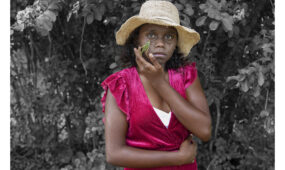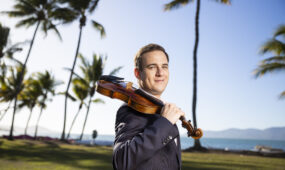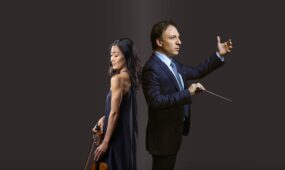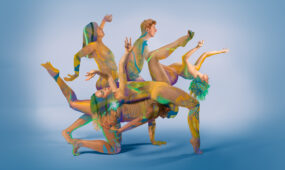Artists' incomes 21% below average – and falling
InReview
New research shows professional artists in Australia earn about a fifth less than most other workers, with SA’s independent arts industry body saying the findings add weight to its state election campaign for increased funding for the sector.

Released today by the Australia Council for the Arts, Making Art Work: An Economic Study of Professional Artists in Australia shows that the average total annual income for professional artists in Australia is 21 per cent lower than the average pay packet.
When pay from all sources was included, the artists’ gross annual income was $48,400 (compared with $50,500 in 2007-08 and $52,300 in 2000-01), with more than three-quarters of survey respondents mixing creative practice with other work.
However, the average amount earned from creative work was just $18,800 a year – 19 per cent less than in 2009. Female artists earn significantly less than males, and those with a disability earn less again.
“Artists are highly skilled professionals with a passionate commitment to their craft – but too often they are expected to work for love, not money,” said Macquarie University Professor of Economics David Throsby, who conducted the research with colleague Katya Petetskaya.
“The digital environment presents new opportunities and challenges for artists. There are more ways to connect with audiences and distribute work, but also greater exposure to unauthorised exploitation of ideas and labours.”
Gail Kovatseff, chairperson of the Arts Industry Council of South Australia, said the findings matched those of a survey carried out several years ago by AICSA and Skills SA.
“The key message that we took from some of our research was that artists are among some of the best educated people in the workforce but the lowest paid.
“It’s a big issue and it’s very concerning because artists put so much energy and time and resources into making first-class work.”
The national survey was based on responses from almost 1000 Australian professional artists surveyed during late 2016 and early 2017.
One of its conclusions was that “digital disruption” was creating both opportunities and challenges for artists, with more collaboration and online sales, but also increased audience expectation of free content and greater opportunities for misappropriation and exploitation. Around a quarter of artists reported their copyright had been infringed in some way.
One of the hazards that professional artists face throughout their career is having to explain why they should be paid for doing what others do for fun
Making Art Work reported that artists draw on a range of structures and entities to support creative work, with 30 per cent applying to the Australia Council between 2010 and 2015, 26 per cent to state and territory governments, and 24 per cent to arts organisations.
“I think it’s great that this report has come out,” Kovatseff said.
“We’re pleased to see it’s back on the agenda and that our campaign around increasing funds for independent artists and the organisations that support them in the small to medium sector is on the money.”
AICSA put a proposal to SA Treasurer Tom Koutsantonis requesting a 40 per cent increase in Arts SA’s funding program for independent artists, small to independent organisations and community arts in this year’s state budget.
“We have put a lot of energy into this – we wrote up a treasury bid but we were very concerned to find that it didn’t make the final 20 bids that were advocated for through the process,” Kovatseff said.
“We believe it’s the most significant question in relation to South Australians being able to tell their own stories, to contribute to creativity, to make work that can tour internationally.”
AICSA, which represents more than 100 SA organisations and artists, will be campaigning on the issue of arts funding in the lead-up to next year’s state election.
While there are no specific figures on whether incomes from creative practice have fallen in SA, Kovatseff said more young artists were leaving the state because they couldn’t find enough work – “so there’s definitely something afoot in terms of people’s ability to develop a sustainable life and income here”.
The report authors can’t fully explain why incomes have declined nationally, although in an article published today on The Conversation they say the data suggests that “genuine creative activity is being curtailed by circumstances over which artists have no control”.
“One of the hazards that professional artists face throughout their career is having to explain why they should be paid for doing what others do for fun – painting, making music, acting, dancing, writing poetry,” Throsby and Petetskaya write in the article.

Get InReview in your inbox – free each Saturday. Local arts and culture – covered.
Thanks for signing up to the InReview newsletter.
“People often don’t appreciate that the level of education, training, experience and skill required to become a professional are at least as rigorous in the arts as they are in other professions like medicine and the law. In fact, the great majority of professional artists (90 per cent) have post-school qualifications compared with only 53 per cent for the general labour force.”
Tony Grybowski, CEO of the Australia Council – which has been subjected to significant funding upheaval over recent years – said the reported showed that action was needed to “ensure the immense value artists provide to our culture, identity and economy is not further compromised”.
“If we want Australian stories to keep being told and Australia’s diverse artistic talent to succeed locally and internationally, we must consider the support structures, protections and remuneration of Australian artists.”
Support local arts journalism
Your support will help us continue the important work of InReview in publishing free professional journalism that celebrates, interrogates and amplifies arts and culture in South Australia.
Donate Here





Comments
Show comments Hide comments